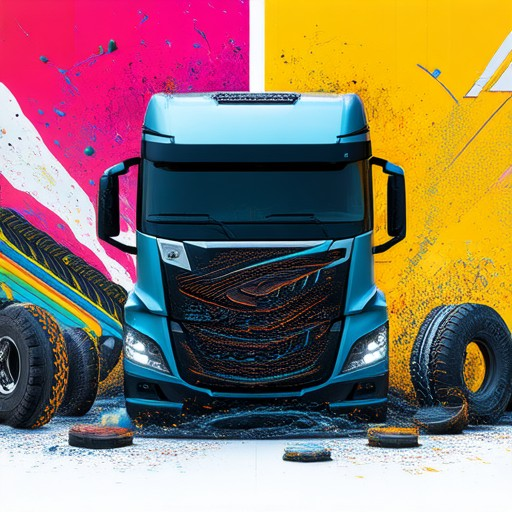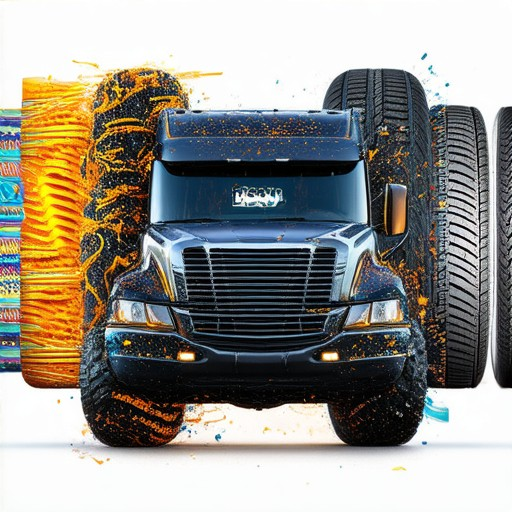Choosing the right tires for your truck isn’t as straightforward as it seems, given the variety of types available. From light truck (LT) to heavy-duty (HD), each option serves distinct purposes and offers unique benefits. Whether you’re navigating city streets or tackling rugged terrain, understanding the differences between tire types can significantly impact your truck’s performance, safety, and longevity. In this guide, we’ll explore the key tire types for trucks, compare popular options, and provide insights to help you select the ideal tires for your needs. By examining factors like load capacity, durability, and traction, this article aims to empower drivers with the knowledge needed to make informed decisions. Let’s dive into the world of truck tires and uncover how the right choice can enhance your driving experience.
Key Takeaways
– Understand the difference between HT (High Traction) and LT (Light Truck) tires to choose the right ones for your vehicle.
– Compare features: HT tires prioritize wet/dry grip and stability, while LT tires offer better load capacity and off-road performance.
– Know when to choose: HT tires are ideal for passenger cars and daily commuting, while LT tires suit light trucks, SUVs, and off-road adventures.
– Consider trade-offs: LT tires provide durability and load-bearing strength but may impact fuel efficiency and handling on paved roads.
– Evaluate speed ratings: H-rated tires are best for high-speed driving, while T-rated tires offer comfort and versatility for everyday use.

What Are the Three Types of Tires?
When selecting the right tires for your vehicle, it’s essential to understand the differences between the various types available. Here’s a breakdown of the three primary categories of tires:
- Radial Tires : These are the most common type of passenger vehicle tire. They feature a continuous pattern of tread around the tire, which enhances stability and grip. Radials are ideal for everyday driving and are suitable for most cars, trucks, and SUVs.
- Bias-Belted Tires : Also known as “bias tires,” these are characterized by their belted construction, which provides better handling and durability. They are commonly used on high-performance vehicles and offer improved traction, especially on wet surfaces.
- All-Terrain Tires : Designed for off-road use, all-terrain tires feature aggressive tread patterns that excel in rough conditions. They provide excellent grip on loose surfaces like mud, sand, and rocks, making them a great choice for trail biking, overlanding, or rugged adventures.
For more information on selecting the right tires for your vehicle, visit our Incubus Wheels resource hub.
Are LT Tires Better Than P Tires?
When deciding between LT (Light Truck) and P (Passenger) tires, it’s essential to evaluate their performance based on your vehicle’s usage and driving conditions.
Performance Comparison
- P-Metric Tires: Ideal for passenger vehicles, offering a balance between traction, comfort, and durability. They excel on paved roads, providing excellent wet and dry grip, and are typically more comfortable for everyday driving.
- LT Tires: Designed for light trucks and SUVs, these tires are built for tougher conditions. They feature deeper treads, enhancing grip on uneven surfaces and loose gravel, and can handle heavier loads, making them suitable for towing or carrying extra weight.
Durability and Comfort
- Durability: LT tires may offer better protection against punctures and tears due to thicker sidewalls, ideal for harsher environments. However, they might wear faster on smoother surfaces compared to P-metric tires.
- Comfort: P-metric tires are generally more comfortable for on-road driving, whereas LT tires prioritize off-road performance, which may translate to a firmer ride on paved surfaces.
Cost Considerations
- LT tires are often pricier initially but may last longer, balancing upfront costs with extended durability.
- P-metric tires tend to be more economical for everyday use but may not offer the same level of off-road performance.
Vehicle Requirements
- If your vehicle is a light truck or SUV designed for off-road use or heavy-duty tasks, LT tires are likely the better choice.
- For passenger vehicles focused on on-road efficiency and comfort, P-metric tires remain the optimal selection.
Conclusion
The choice between LT and P tires hinges on your vehicle’s intended use. LT tires excel for off-road adventures and heavy-duty applications, while P-metric tires deliver superior on-road performance and comfort. Evaluate your driving needs to select the most suitable tire type for your vehicle.

What is the Best Tire for a Truck?
The best tire for a truck depends on its intended use, whether it’s for daily commuting, heavy-duty work, or off-road adventures. Here’s a breakdown of the top options:
1. All-Terrain Tires
All-terrain tires are a versatile choice for trucks. They provide excellent traction on various surfaces, including mud, gravel, and light snow. Brands like Goodyear and Bridgestone offer reliable all-terrain options.
2. Off-Road Tires
If your truck frequently ventures off the beaten path, consider specialized off-road tires. These tires have aggressive tread patterns for maximum grip and are built to handle rough terrain. Michelin ‘s LTX AT2 is a popular choice for serious off-roading.
3. Highway Tires
For highway driving, focus on tires designed for comfort and fuel efficiency. The Michelin Defender is a great option, known for its long-lasting tread and excellent performance on smooth roads.
4. Winter Tires
Winter tires are essential if you face frequent snow or icy conditions. The Hankook Winter Radial is highly rated for its exceptional grip in cold weather.
Factors to Consider
- Load Capacity: Ensure the tire can handle your truck’s weight, especially when loaded.
- Tread Depth: Check for sufficient tread to maintain traction and durability.
- Durability: Look for tires with strong sidewalls and robust construction for long-life performance.
- Price: Balance between quality and budget to find the best fit for your needs.
Conclusion
For everyday use, the Michelin Defender excels in both wet and dry conditions. For off-road adventures, opt for the Michelin LTX AT2 . Always consult with a professional tire installer to ensure the correct size and type for your truck’s specific requirements.

What’s the Difference Between HT and LT Tires?
HT (High Traction) and LT (Light Truck) tires are two types of specialized tires designed for different purposes. Understanding the differences between them can help you choose the right tires for your vehicle.
- High Traction (HT) Tires: These tires are optimized for maximum grip and stability on various surfaces. They are ideal for everyday driving, providing excellent performance on wet, dry, or snowy roads. HT tires are commonly found on passenger vehicles and family sedans.
- Light Truck (LT) Tires: LT tires are built for lighter trucks, SUVs, and crossover vehicles. They offer a balance of durability and performance, making them suitable for both on-road and light off-road use. LT tires are designed to handle heavier loads and provide better traction compared to standard passenger tires.
Key Features
- HT Tires:
- Excellent wet and dry grip
- Quiet and comfortable ride
- Wide tread pattern for improved stability
- LT Tires:
- Better load capacity
- Improved off-road performance
- Durable construction for heavy-duty use
When to Choose Each Type
- Choose HT tires if you drive a passenger car or need all-season performance for daily commuting.
- Opt for LT tires if you own a light truck, SUV, or require tires for hauling equipment or occasional off-road adventures.
Both tire types are designed to enhance safety and performance under different conditions. Whether you’re driving on city streets or exploring rough terrain, having the right tires can make a big difference in your driving experience.
Visit our store to explore our selection of high-quality HT and LT tires.
Should I Buy H or T Tires?
Tire speed ratings play a crucial role in determining the optimal choice for your vehicle. Here’s a breakdown of H and T-rated tires:
- H-Rated Tires: Designed for speeds up to 130 mph, these tires are ideal for high-speed driving, suitable for sedans and commuter vehicles. They offer enhanced stability and handling at higher velocities.
- T-Rated Tires: Rated for up to 118 mph, these tires are recommended for family sedans and vans, emphasizing comfort and durability for everyday driving.
Consider your driving habits and vehicle requirements. If you frequently travel on highways or require high-speed stability, H-rated tires may be preferable. Conversely, T-rated tires provide excellent performance for city driving and general use, potentially offering better mileage and durability.
Check your vehicle’s owner manual to confirm the recommended tire size and rating. Evaluate factors like cost, wear and tear, and weather conditions to make the best choice for your situation.

Disadvantages of LT Tires
While LT tires offer exceptional performance for trucks, vans, and jeeps, they also come with several drawbacks:
- Weight and Size: LT tires are significantly heavier and bulkier than standard passenger tires. This added weight can reduce fuel efficiency and increase the overall weight of the vehicle, which may affect its handling and maneuverability.
- Cost: Due to their specialized construction and larger size, LT tires are generally more expensive than standard tires. This can be a significant factor when budgeting for tire replacements or upgrades.
- Fuel Efficiency: The increased weight and rolling resistance of LT tires can lead to lower fuel efficiency compared to lighter, more efficient passenger tires. This is particularly noticeable in vehicles that rely heavily on mileage performance.
- Handling and Stability: While LT tires excel in off-road conditions, they may not always provide the same level of stability and control as smaller, more agile tires on paved roads or smooth surfaces.
- Durability Concerns: Although durable, LT tires are more prone to damage from rough terrain, curbs, or potholes due to their larger size and increased flexibility. This can shorten their lifespan compared to standard tires in certain driving conditions.
- Space Constraints: The larger size of LT tires can make it challenging to fit them into tight spaces, such as in smaller vehicles or when storing them. This can be inconvenient for owners with limited storage options.
When considering the purchase of LT tires, it’s essential to weigh these disadvantages against their benefits to determine if they align with your specific needs and usage patterns. Always consult with a trusted mechanic or tire specialist to ensure you’re making the best choice for your vehicle.




0 Comments